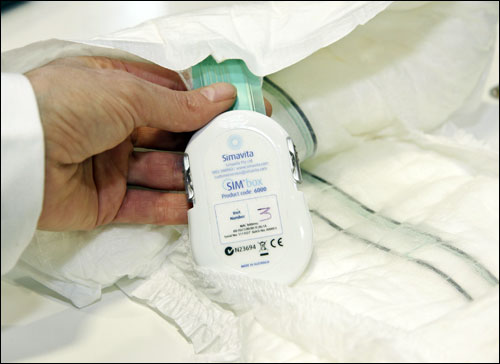Electronic underpants that monitor and detect incontinence, and then wirelessly transmit alerts to nursing-home staff members, could soon be in use around the globe. Australian firm Simavita unveiled the electronic undergarments earlier this year, which it hails as a world’s first, claiming the product will make the lives of incontinence sufferers easier, while also improving staff efficiency at senior-care centers, and reducing the overall costs of elderly care. The company’s Smart Incontinence Management System (SIMsystem) employs wireless ZigBee-based moisture-detecting sensors embedded within a customized continence pad worn by aged-care residents.
According to Simavita, an estimated 80 percent of senior-care residents suffer from incontinence, costing the Australian government up to $1.5 billion annually to manage. But in trials, the company reports, the SIMSystem saved up to $2,000 in labor costs per bed, per annum.

Philippa Lewis, Simavita’s chief executive, says an aging population, coupled with workforce shortages, has put significant pressure on governments and communities worldwide to develop solutions to improve the quality of senior care.
“To date,” Lewis says, “the only way clinicians have been able to accurately assess the patterns and type of incontinence has been via a rigorous and demanding manual method. This requires a caregiver to check, change and weigh the incontinence pad. This is labor-intensive, produces inaccurate results from which to prepare care plans, and is extremely challenging and embarrassing for any elderly person.”
As the population continues to age, and as the cost of aged care continues to rise, Lewis believes it will become necessary to develop technology that delivers labor efficiencies and improves care for seniors.
The SIMsystem, she says, offers significant benefits for the elderly and caregivers alike. For employees, it provides more accurate information regarding incontinence, leading to fewer attendances, less paperwork regarding compliance, reduced health and safety risk from manual handling, and greater time available for direct care of residents. For nursing homes, it delivers reduced labor costs, improved staff productivity, reduced laundry costs, lower pad consumption, and evidence for accreditation and funding purposes.
And for residents, it means fewer unnecessary intrusions, more personalized care and improved quality of life.
Samarinda Lodge, an elder-care facility in Ashburton (a suburb of Melbourne), recently rolled out the SIMsystem, with cost pressures the driving force behind its decision. Tanya Gilchrist, Samarinda’s chief executive, says incontinence is a significant factor in providing residential care to seniors, in terms of both product use and staff time.
“It could take two staff up to 15 minutes to attend a resident,” Gilchrist explains. “Without an accurate picture of a person’s continence or toileting patterns, this is frequently time spent at the wrong time, either too early or too late, which results in staff needing to re-attend residents. With workforce shortages and pressures on staff time, it is very important that we work smarter and address inefficiencies.”
Samarinda took part in early trials of the system, Gilchrist says, so it knew the potential benefits. The elder-care facility also took part in studies with the Centre for Health Innovation, a health-care research center based in Melbourne. The study identified continence management as one of the most labor-intensive tasks in an aged-care center. And while staff participation is often a challenge with new technologies, she says, the SIMsystem is an area in which workers quickly see and feel the difference.
“The benefits for staff are that they save time through individualized toileting, and improved job satisfaction, since staff are better able to use the time they have,” Gilchrist states. “Ultimately, people in this industry are here for the residents, and anything that improves their care is seen as a positive.”
She adds, “For Samarinda, there are potential improvements in funding through better understanding of residents’ continence status, and reduced cost of continence aid through understanding each individual’s specific requirements and being able to provide the right aid at the right time.”
The SIMsystem, developed over the past 15 years, was originally conceived by Fred Bergman, a Melbourne doctor. Bergman developed the first prototype, and the Australian government funded the first clinical trial in 2004. Although the physician died shortly before the trial began, Simavita continued his work, launching the first commercial trial in 2009.
“All in all, we conducted five trials of the system in aged-care facilities between 2006 and 2009,” Lewis says. “We identified many issues during these trials, but even as a prototype system, it was useful in developing improved continence-care plans for residents.”
Some of the challenges Simavita encountered included the complexity of detecting incontinence, such as differentiating between incontinence and other conditions, like sweat. Since the wireless system sends data packets to a central server for analysis every few seconds, it was also necessary to develop a robust, reliable network that supported multiple monitors, provided 100 percent transmission unshielded by the body mass of residents wearing the units, and had sufficient battery life. It also needed to be easy for the care staff to use, as the initial prototypes were difficult and time-consuming, which sometimes led to errors.
The SIMsystem features a pad with a moisture-sensing strip physically connected to the SIMbox, a transmitter unit held in a pouch on the front of specially designed underpants. The battery-powered SIMbox sends readings via the ZigBee protocol to a SIMgateway connected to a dedicated server running SIMsystem Manager software, which analyses the information and alerts employees via SMS text message whenever a resident requires assistance. Over a three-day assessment, the SIMsystem Manager automatically logs all voiding events and alerts the staff via SMS when a resident requires assistance. Workers can then use that data to determine the type and degree of continence, select the best type of continence aid to be used, and implement a toileting schedule for that particular resident.
According to Simavita, the SIMsystem is currently installed in 20 aged-care centers across Australia, with plans to roll it out to 200 additional sites this year. There is also significant global interest, the company reports, with a European licensee already established.

